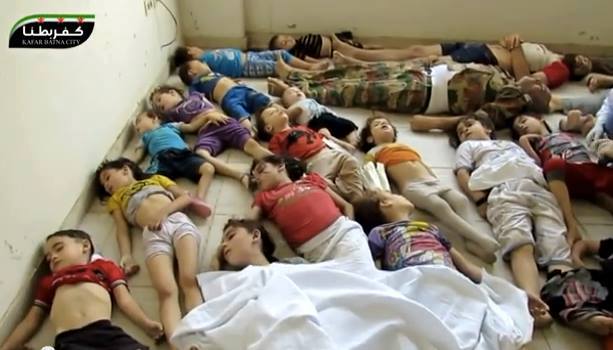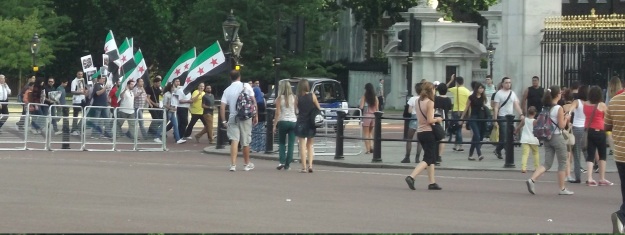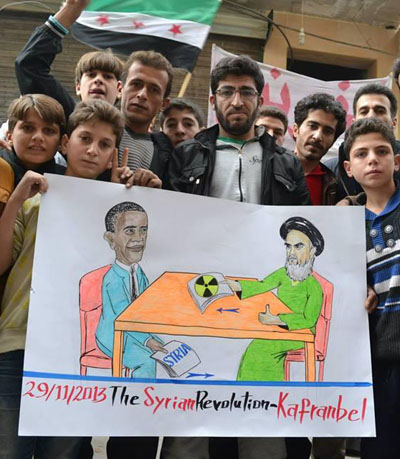By Kyle Orton (@KyleWOrton) on August 21, 2014
Can it really be twelve whole months since Bashar al-Assad gassed to death more than 1,400 people in a morning? I happened to be in London when the attack on the Damascus suburbs of Ghouta took place, exactly a year ago. London has become (in)famous recently for mass-protests that throw around the word “genocide“—against Israel’s (in my view ill-thought out) recent response to HAMAS’ rocket fire. London had no time for Syria’s grief: a tiny protest outside Buckingham Palace in the early evening of Aug. 21, 2013, was made up mostly of Syrian expats, and the picture I took (below) is among the only evidence even that took place.
The events of last August and September have been spun every-which-way by all corners of the political landscape. To try to recall what actually happened is thus some effort.
The most pressing myth to dispense with is that the “deal” reached to ostensibly remove Assad’s chemical weapons of mass destruction (CWMD) was the Obama administration’s original intent, that in other words they got with the mere threat of force what they wanted all along. On August 18, 2011, President Obama declared that Bashar al-Assad must “step aside“. U.S. policy was, therefore, one of regime-change. After the CWMD attack President Obama insisted that while he had “no interest in any open-ended conflict … we do have to make sure that when countries break international norms … they are held accountable.” The key word at the time was “punish“. It was understood—even before John Kerry’s “unbelievably small” outburst—that this was to be a limited, essentially cosmetic military operation designed to show displeasure at Assad’s behaviour.
After the British House of Commons disgraced itself on August 29 by voting to allow chemical massacres with impunity, President Obama, while insisting on his Executive authority, threw the matter to Congress on August 31. He wanted buy-in on an operation he clearly did not want to do in order to spread the political cost. Obama had helped institute this mood of isolationism in America and then boxed himself in, to the shock off his staff, with a “red line” on CWMD, which had been issued off-the-cuff to forestall chemical atrocities impending from the Assad regime in August and then December 2012. Obama had said the strikes were not “time-sensitive,” but that was not how it was seen in France: French jets were on the tarmac ready to go when Obama announced that the matter was now being referred to Congress. French President Francois Hollande had risked the wrath of an eternally-anti-American popular will to stand with Obama, but he needed a lightning strike against Assad; it is much easier to ask forgiveness than it is to get permission.
The message conveyed by this improvisation and hesitancy was, “Hand me a fig leaf and I will retreat,” as Michael Doran put it. The strikes were a non-negotiable: they were meant to punish the dictator. But on September 9, Kerry made a supposedly-spontaneous statement—a “goof” indeed—in London offering to call off the strikes if Assad ceded his CWMD. In reality, Russia had been pressing this scheme since June 2012, and had voiced it again directly to Obama on September 6. Suddenly the strikes were off altogether, and administrative details were being worked out at the United Nations to remove Assad’s CWMD stockpile.
Since the “deal” was a “classic case of Moscow’s active measures,” it was hardly surprising that most immediate effect it had was creating a Western interest in the preservation of the Assad dictatorship, which was now a partner in disarmament. When the U.N. Security Council finally passed the resolution formalising this deal after nearly a month of wrangling on September 27, the U.N. secretary-general said this was not “a license to kill with conventional weapons.” But he did protest too much, and it was worse: it made the deal-brokers accomplices to the regime’s military operations. In November, the regime took its campaign of atrocity into as-Safira, Aleppo, and Qalamoun, north of Damascus, in the name of securing a CWMD production facility in the first case, and the roads to the coast where the chemicals were to be shipped out of Syria, in the second. In response, the U.N. official overseeing the disarmament process approvingly said the regime was “taking steps to secure” the overland routes to the coast. This was the price of what Obama called a “peaceful” solution in his September 11 speech abandoning the effort to get Congress to vote for the strikes.
Obama had never wanted to get involved in Syria. In December 2011, Obama told the Iraqi Prime Minister: “We have no intention to intervene militarily” in Syria. All of the President’s actions since then flowed from that initial decision to stay out, and the analysis was bent to fit that conclusion. By September 2013, however, there was an additional reason for Obama to stay out of Syria: secret talks were ongoing, having started in late 2011, with clerical Iran to have it reach an interim accord that would pause its nuclear weapons program. A tacit condition was that Tehran would be given Syria in exchange for a delay on its nuclear ambitions. As one of the administration’s “realist” supporters explained:
“[T]o have any chance of getting things done with Iran, America needs to be talking with the Iranians—not shooting at them in Syria or anywhere else.”
If America had engaged, she would indeed have been shooting at the Iranian regime, which has now taken over the security sector of the Syrian State. The regime had degraded into “an entity more akin to a militia,” or more properly several entities. By November 2012, the rebels had more than 50,000 men and the the regime was down to at most 38,000 usable troops. In an effort to rescue its client, in late 2012 and early 2013 Iran combined these paramilitary squads into a sectarian militia with a unified command, the National Defence Forces (NDF). The NDF is overseen by Iran’s foreign intelligence chief, Qassem Suleimani. By all accounts the Iranians were looking for a more professional counter-insurgency force; the Alawite commanders were looking for a more effective formation to “kill the Sunnis and rape their women“. This is the force the chemical weapons “deal” made us accomplices to.
Would that merely being sullied by co-operation with a dictatorship like this were the least of it. It’s not just that CWMD were always a sideshow: in September 2013, 110,000 people were dead; now more than 220,000 people are, and conventional weapons were the difference. But for all this sacrifice—which included nearly destroying the moderate opposition—we’re not even getting Assad’s CWMD. The West did get Assad’s declared stockpile out of Syria, which has been destroyed. A cynic might wonder if the timing wasn’t meant to be a partial answer to the inevitable questions directed at the White House of what has been achieved. But let it pass. It is still a fact that CWMD stockpiles are the least important: stockpiles do not take long to generate, so it is the production facilities that have to be gotten rid of. The UNSCR clearly says that Assad was to dismantle all production facilities but even by April it was obvious that the regime was maintaining twelve (known) facilities as “leverage,” and since some secret facilities have already been exposed, it is to be expected there will be more. By last month it was announced that Assad would be allowed to negotiate the clearly written terms of the UNSCR. The regime has foot-dragged at every turn, and why not? The moment the “deal” is complete, the fig leaf falls, and Obama is out of excuses for not trying to topple a dictator he said three years ago had to leave.
In April, the regime added to obstructionism the actual use of poison gas, mostly chlorine, against the Syrian population, especially in areas like Hama where the moderates were gaining. (There have been no chlorine attacks—or barrel bombs if it comes to that—on the Islamic State’s headquarters in Raqqa.) Because chlorine has legitimate uses like sterilising swimming pools it is not categorically banned by the Chemical Weapons Convention (CWC), which the Assad regime has now signed, a major victory according to the Obama administration. In June, the U.N. inspectors said that Assad regime was almost certainly responsible for the chlorine attacks. But this hasn’t stopped them. Just last night the regime attacked Jobar, east Damascus, with toxic gas of some kind. Earlier this month it was announced that weapons inspectors are heading back to Syria, purportedly to address “technical questions” related to the regime’s declaration. Expect the process to drag on.
There should be no euphemism about this: that chemical weapons “deal” Obama struck was a defeat for the West and the rebellion and a victory for the Kremlin and Assad. The dictator got international legitimacy, and Moscow shattered Obama’s position in the Middle East. Now Vladimir Putin could be positioned as the man through whom all matters in the region run, and in the meantime Putin had made Syria an advertisement: Putin would stand by dictators in their darkest hour, with real support to help them cling on—unlike, so the perception has it, America with (say) Hosni Mubarak—so why would they look to a United States that might condition their aide on irritations like human rights? Egypt’s Abdel Fattah as-Sisi was the first to flirt with this new, authoritarian-friendly option.
At the end of 2013, with not just then-ISIS, but Jabhat an-Nusra (al-Qaeda) and the newly-minted Islamic Front seemingly ascendant there was a great temptation to despair and fatalism; the Syrian Salafists had overtaken the nationalists and seemed to be serving as an incubator for globally-minded Salafi-jihadist forces. The January 3 anti-ISIS revolt was in our future and has forever altered the landscape in Syria. The dividing lines in the insurgency are much clearer now: the Islamic State is opposed by even very extreme Syrian forces like Ahrar a-Sham, and Nusra is preparing to “come out” with its own attempt to impose a shari’a despotism on Syria, which has already led to clashes with the rebellion in Deraa.
The rebellion has increased its cohesiveness but it still remains divided and those who wish to fight for it still lament that there are thousands of “fighters … sitting in Turkey waiting for support and weapons to go back to Syria.” These are the more secular-minded early activists-turned-rebels and the secular-inclined military defectors—since, contrary to President Obama’s belief that this is a rebellion of farmers, teachers, and pharmacists, a probable-majority of rebels are defected soldiers. If Afghan peasants can, with American backing, put to flight the Red Army, odds seem good that a military-led insurgency against a ramshackle tyranny like Assad’s can be overcome if it has American support. The FSA-style program remains what most Syrians want, but the FSA-type rebels have been unable to militarise their support to compete on the battlefield. The West stood aloof from this rebellion and the Khaleeji donors, favouring Salafism and sectarianism, were allowed to take the lead; it meant even nationalist forces felt the pull to appear more Salafist, from beards to insignia, to get funds.
The coming contest for Aleppo will more than likely determine the outcome of this rebellion. If the rebels are pushed out of Aleppo City then it is game-over. As ever, the rebellion is being attacked on two fronts, by the regime and the Islamic State. I.S. is sweeping into Aleppo from the east and has surrounded Marea, the birthplace of Abdul Qadeer as-Saleh, the now-deceased leader of Liwa at-Tawhid, which was the largest rebel brigade in Aleppo until it split in two. I.S. are also just about to take over Kuweris airbase east of Aleppo City. The fall of Kuweris is long-anticipated. It had not been expected that Marea would be in such bad shape; if it falls, it opens the road to Azaz and the whole north-west area of Aleppo to I.S., the zone near the Turkish border. The regime has been somewhat set back by these I.S. gains but this is cold comfort to the rebellion. As one activist put it, “You look to the right, and there’s the regime. You look to the left, it’s the Islamic State. We are caught in a pincer.”
The regime gets all the support it needs from tyrannical States abroad, the takfiris fund themselves (largely with regime oil), al-Qaeda and the Syrian Salafists get their support, while the nationalists wait on the West, and the killing goes on. In short, we’re where we were a year ago—only worse.
Update (Oct. 20, 2014): There have been many theories about why the Assad regime used nerve agent when it did. The matter of why this would be done with the U.N. inspectors having only just arrived is easy: the regime wanted to terrorise the population, to show that it could not be restrained by international opinion, and that those who bet on international help would get their families murdered. There is good evidence that the regime was struggling in East Ghouta in August 2013, and this led to a suggestion that it had turned to poison gas in desperation. Some contested this, but the build-up of the nationalist rebels east of the capital, and the increasingly evident Saudi support of same, marginalising both the jihadists and the regime, seems unarguable.
This is where a report by Isabel Nassief for the Institute for the Study of War comes in. As then-ISIS was overtaking the Western-backed structures like the SMC in the summer of 2013, especially in the north, one reason was that the FSA-branded rebels had begun to plan for an attack on Damascus. The regime’s media, and supportive media in Russia, was full of stories just before the Ghouta atrocity that “U.S.-trained forces would be coming online in August in support of a major rebel offensive on the capital.” Assad’s propaganda about a foreign conspiracy against him is not solely for public consumption, and it is at least conceivable that the Ghouta chemical attack was an attempt to preempt what Assad believed was to be a mortal threat to him from these foreign conspirators.



My memorial blog for Ghouta: http://rememberghouta.wordpress.com/
LikeLike
Pingback: Obama Declares War On The Islamic State … Kind Of | The Syrian Intifada
Pingback: Russian Intelligence and the War In Syria | The Syrian Intifada
Pingback: What To Expect From The Nuclear Negotiations With Iran | The Syrian Intifada
Pingback: Working On Weapons of Mass Destruction For the Iranian Axis Is A Dangerous Job | The Syrian Intifada
Pingback: Obama Won’t Help Rescue Syria’s Revolution: He Has Given Syria To Iran | The Syrian Intifada
Pingback: Nuclear Negotiations With Iran Go On—And On And On | The Syrian Intifada
Pingback: Sanctions Alone Won’t Stop Putin | The Syrian Intifada
Pingback: Iran Tries To Get American Support For Its Takeover Of Lebanon | The Syrian Intifada
Pingback: From Kessab to Cannibals: Syria’s Media War | The Syrian Intifada
Pingback: America’s Silent Partnership With Iran And The Contest For Middle Eastern Order: Part Two | The Syrian Intifada
Pingback: America’s Silent Partnership With Iran And The Contest For Middle Eastern Order: Part Four | The Syrian Intifada
Pingback: Netanyahu Spoke The Truth About Iran At Congress | The Syrian Intifada
Pingback: Netanyahu Spoke The Truth About Iran At Congress | The Office of Robbie Travers
Pingback: Agora Speaks 2015: Part 1 | Agora
Pingback: Why I Can’t Bring Myself To Vote On May 7 | The Syrian Intifada
Pingback: Obama’s Iran Deal Increases Nukes, Terrorism, and Instability | The Syrian Intifada
Pingback: Book Review: The Consequences of Syria (2014) by Lee Smith | The Syrian Intifada
Pingback: America Not Training Syria’s Rebels Isn’t “Failure”; It’s Policy | The Syrian Intifada
Pingback: Russia’s War For Assad | The Syrian Intifada
Pingback: Barack Obama Comes Clean | The Syrian Intifada
Pingback: United States policy in the Middle East: Catch-22
Pingback: International Taboo on Chemical Weapons Frays As U.S. Steps Back | The Syrian Intifada
Pingback: Why The Obama Doctrine Failed | The Syrian Intifada
Pingback: France Presents Evidence Assad Committed Chemical Weapons Atrocity | The Syrian Intifada
Pingback: Syria’s Regime Conducted the Khan Shaykhun Chemical Attack, United Nations Concludes | The Syrian Intifada
Pingback: Syria’s Revolution Has Been Overtaken By Outside Powers | The Syrian Intifada
Pingback: HOW SYRIA REVOLUTION TURNED INTO GLOBAL BATTLEFIELD – linesstatic
Pingback: Trump Should Not Fear Russia In Responding to Assad’s Chemical Attack | The Syrian Intifada
Pingback: Trump’s Syria Strike Upheld an Important International Norm, But Did No More | The Syrian Intifada
Pingback: Rebel-Turned-Jihadist Saddam al-Jamal Reported Captured | The Syrian Intifada
Pingback: The Failure of the United Nations in Syria | The Syrian Intifada
Pingback: Trump Completes Obama’s Syria Policy / Kyle Orton's Blog
Pingback: Russia's War For Assad | Kyle Orton's Blog